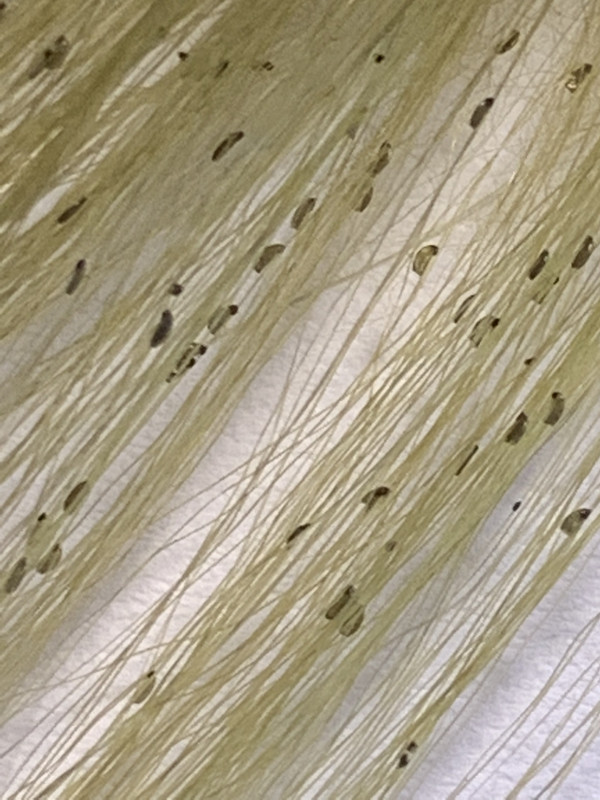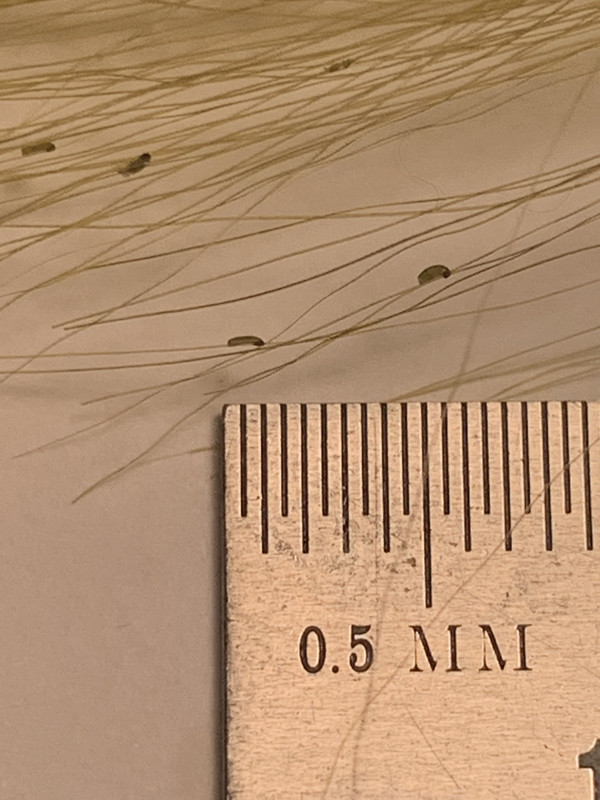Safe Material Storage
Posted: Sun Dec 06, 2020 12:45 pm
As Dana said on the Golden Plover thread, we need a thread on safe material storage. The apocalypse finally struck me at last--it was bound to happen--when I discovered intruders in my tub of Collins capes. $%#@!! But it wasn't too bad--it seems a single cape got past my usual quarantining process, and infected about a half dozen others in the tub. They got cleaned and deposited in the freezer for now. Our tradition enemy, moth larvae.
But as I was going through all my materials and fly archive, I noticed in one tub containing dyed cashmere goat that a number of pieces were infected with what seemed egg casings--and can't put my finger on what they are. They are very small--.8mm-1mm long, and are attached to the strands of hair with a sticky substance--sort of like lice eggs in human hair. Except smaller. Plus, they are greyish-black, not white, though that might be because they are shucks. Does anyone have an idea what they are? Here's a pair of pics:

and for sizing:

I had last used this tub in the January when tying out at the Roger Brown House in New Buffalo, Michigan--it's located on the sand dunes along the shore. Temps were warm--50s, 60s. My first thought was: fleas--flea eggs--as the dog was running out in the dune grass every day, and coming into the studio with me when I tied--. But from what I have read, flea eggs are loose, and not 'glued' like these are.
Bird mites? Anyone have any other ideas? Or suggestions for who might know?
It's funny almost--as I told Phil A. and John S. this morning, here I am trying to make fake bugs to imitate real bugs, and I am getting attacked by evil bugs in the process. It’s worthy of Shakespeare. Revenge tragedy. We’re only in act 2 right now—what scholars call ‘the discovery.” God save me in act 3 when we hit the peripety. LOL.
So--regarding flea collars in storage bins--how do you all do this? There's a lot of variation in collars out there, some are 'natural ' (lol) and some are outright fakes of expensive Bayer collars. When you cut the collars up, do you just drop a piece in the bin or the bag? Do you put it in its own small bag with holes so it doesn't touch the materials?
Thoughts?
Thanks,
bb
But as I was going through all my materials and fly archive, I noticed in one tub containing dyed cashmere goat that a number of pieces were infected with what seemed egg casings--and can't put my finger on what they are. They are very small--.8mm-1mm long, and are attached to the strands of hair with a sticky substance--sort of like lice eggs in human hair. Except smaller. Plus, they are greyish-black, not white, though that might be because they are shucks. Does anyone have an idea what they are? Here's a pair of pics:

and for sizing:

I had last used this tub in the January when tying out at the Roger Brown House in New Buffalo, Michigan--it's located on the sand dunes along the shore. Temps were warm--50s, 60s. My first thought was: fleas--flea eggs--as the dog was running out in the dune grass every day, and coming into the studio with me when I tied--. But from what I have read, flea eggs are loose, and not 'glued' like these are.
Bird mites? Anyone have any other ideas? Or suggestions for who might know?
It's funny almost--as I told Phil A. and John S. this morning, here I am trying to make fake bugs to imitate real bugs, and I am getting attacked by evil bugs in the process. It’s worthy of Shakespeare. Revenge tragedy. We’re only in act 2 right now—what scholars call ‘the discovery.” God save me in act 3 when we hit the peripety. LOL.
So--regarding flea collars in storage bins--how do you all do this? There's a lot of variation in collars out there, some are 'natural ' (lol) and some are outright fakes of expensive Bayer collars. When you cut the collars up, do you just drop a piece in the bin or the bag? Do you put it in its own small bag with holes so it doesn't touch the materials?
Thoughts?
Thanks,
bb